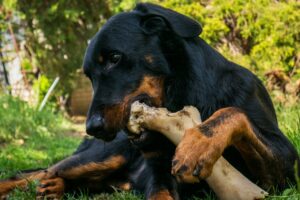Dogs have an innate urge to chew things, and one of their favourite things to chew is bones.
Bones are an excellent source of important nutrients such as calcium, phosphorus and magnesium. They’re also a natural source of glucosamine and chondroitin sulphate, which can be beneficial for dogs with joint issues. But many people are wary of feeding their dog bones for fear that they may splinter and cause digestive issues or even lead to choking. Let’s take a look at the pros and cons of feeding your dog bones, as well as some bone-friendly alternatives.
What are the benefits of feeding your dog bones?
There are many benefits to feeding your dog bones – it satisfies their urge to chew, provides mental stimulation, relieves boredom and makes them happy.
Bones are a natural source of protein, minerals and nutrients that make great contributions to a healthy, well-rounded diet. Bones are also an excellent source of dietary calcium and phosphorus, which are key nutrients for growing puppies. If you’re feeding your dog meat bones, they’re also an excellent source of glucosamine and chondroitin sulphate, which are important for maintaining joint health.
Bones are a great source of dietary fibre, which can help support healthy digestion and may reduce the risk of certain types of cancers.
As well as being healthy to eat, many dogs enjoy gnawing on bones, which can help with dental hygiene and keeps your dog’s teeth clean and gums healthy. While it doesn’t replace regular visits to the vet for dental cleaning, adding raw, fresh bones to your dog’s diet can reduce the incidence of canine tooth disease.
Are there any risks associated with feeding your dog bones?
The answer to this question is yes. It’s important to be aware of the risks associated with feeding your dog bones, as they can be dangerous and cause injury and harm if they are not fed safely or correctly.
Although bones are a healthy part of a dog’s diet, they must be given in moderation and certain types are not safe to feed to dogs. Before you feed your dog any bones, it’s important to identify the best type, as some may be too brittle, too hard or too large to digest safely. When your dog eats a bone, it’s broken down in stages as it travels through their digestive tract. While this may seem like an inefficient way to digest bones, it’s actually very important, as it allows their body to extract all of the nutrients from the bone.
One of the biggest mistakes people make when they give bones to their dogs is that they cook them. Cooked bones of any kind are dangerous because they can break into shards, which can cut into your dog’s mouth as well as cause internal injury to their digestive tract.
Ham and other salty meats are very dangerous to pets, so avoid giving your dog leftover meat or bones from the cooked meat. High in fat and salt content, these meats can cause serious stomach ache or pancreatitis.
Small bones such as chicken bones can also be dangerous. If your dog tries to swallow small bones, and they get stuck in their throat, they can have the bone stuck between their molars in the roof of their mouth.
Chewing on bones can also cause damage or fracture dog’s teeth. These fractures can be quite painful and often mean the tooth needs to be extracted.
What are the best types of bones for dogs?
Chewing bones can be safe, but can cause problems for your dog if your bone of choice is poor.
Most raw bones that have not been cooked are edible for your dog. Raw beef, chicken, lamb or turkey bones are soft enough to chew and digest.
Dogs with sensitive stomach, pancreas or weight problems should not be fed bones with excessive fat or bone marrow, as it adds too much fat to their diets.
Larger dogs should be given large bones that allow your dog to chew more reduce the likelihood that they will break off and swallow dangerous chunks. If your dog starts to break off large pieces of bone or becomes too small to chew, take the bone and replace it with lots of pats and cuddles (their mouths and stomachs will thank you later).
For smaller dogs, it’s ok to give them large bones such as a sheep or cow femur bone – they may have a bit of trouble getting their mouth around them, but it will keep them occupied for a while!
Alternatives to feeding your dog raw meat and bones
If you’re wary of giving your dog bones, there are plenty of non-boned treats and chews that are both healthy and delicious.
Dental sticks and bone-shaped chew toys are a safe alternative, as are jerky treats which are a great source of protein and are excellent for rewarding your dog while they’re training. They’re also a good source of B vitamins, which are important for maintaining a healthy metabolism. Just make sure to choose the lower-sugar versions.
At Paddington Pups, we stock a selection of chewy alternatives if you decide against raw bones for your pup! These alternatives are a great way to satisfy your dog’s natural urge to chew without the risks that can be associated with feeding your dog bones.
Bones can be fed as part of a healthy diet for your dog, but you must do so safely and be aware of the risks to ensure the wellbeing of your dog. If you’re feeding your dog bones, make sure to choose the best type and monitor your dog’s digestion to look for signs of discomfort. Talk to your vet if you have any concerns or to seek advice to help you decide if the benefits of giving your dog bones to chew outweigh the risks.